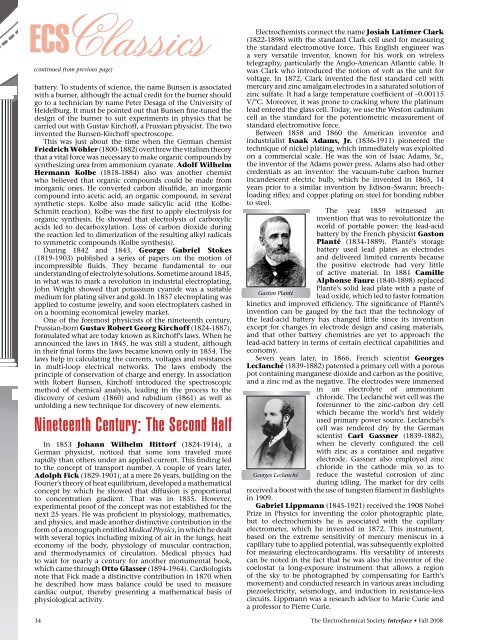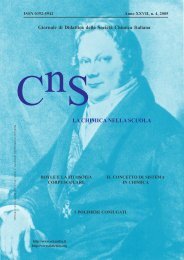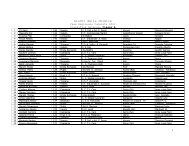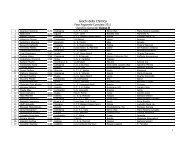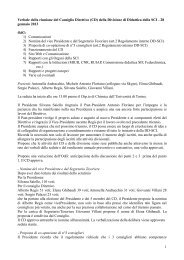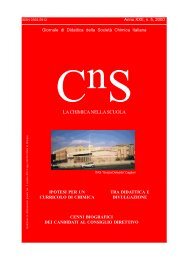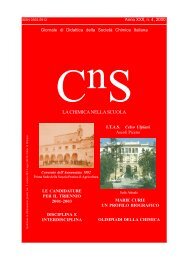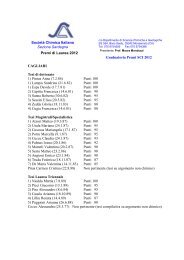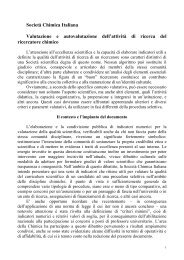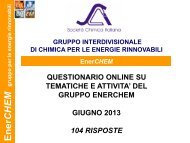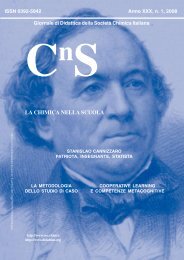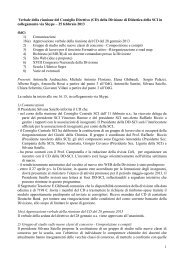ECS Classics - The Electrochemical Society
ECS Classics - The Electrochemical Society
ECS Classics - The Electrochemical Society
You also want an ePaper? Increase the reach of your titles
YUMPU automatically turns print PDFs into web optimized ePapers that Google loves.
<strong>ECS</strong> <strong>Classics</strong><br />
(continued from previous page)<br />
battery. To students of science, the name Bunsen is associated<br />
with a burner, although the actual credit for the burner should<br />
go to a technician by name Peter Desaga of the University of<br />
Heidelburg. It must be pointed out that Bunsen fine-tuned the<br />
design of the burner to suit experiments in physics that he<br />
carried out with Gustav Kirchoff, a Prussian physicist. <strong>The</strong> two<br />
invented the Bunsen-Kirchoff spectroscope.<br />
This was just about the time when the German chemist<br />
Friedrich Wöhler (1800-1882) overthrew the vitalism theory<br />
that a vital force was necessary to make organic compounds by<br />
synthesizing urea from ammonium cyanate. Adolf Wilhelm<br />
Hermann Kolbe (1818-1884) also was another chemist<br />
who believed that organic compounds could be made from<br />
inorganic ones. He converted carbon disulfide, an inorganic<br />
compound into acetic acid, an organic compound, in several<br />
synthetic steps. Kolbe also made salicylic acid (the Kolbe-<br />
Schmitt reaction). Kolbe was the first to apply electrolysis for<br />
organic synthesis. He showed that electrolysis of carboxylic<br />
acids led to decarboxylation. Loss of carbon dioxide during<br />
the reaction led to dimerization of the resulting alkyl radicals<br />
to symmetric compounds (Kolbe synthesis).<br />
During 1842 and 1843, George Gabriel Stokes<br />
(1819-1903) published a series of papers on the motion of<br />
incompressible fluids. <strong>The</strong>y became fundamental to our<br />
understanding of electrolyte solutions. Sometime around 1845,<br />
in what was to mark a revolution in industrial electroplating,<br />
John Wright showed that potassium cyanide was a suitable<br />
medium for plating silver and gold. In 1857 electroplating was<br />
applied to costume jewelry, and soon electroplaters cashed in<br />
on a booming economical jewelry market.<br />
One of the foremost physicists of the nineteenth century,<br />
Prussian-born Gustav Robert Georg Kirchoff (1824-1887),<br />
formulated what are today known as Kirchoff’s laws. When he<br />
announced the laws in 1845, he was still a student, although<br />
in their final forms the laws became known only in 1854. <strong>The</strong><br />
laws help in calculating the currents, voltages and resistances<br />
in multi-loop electrical networks. <strong>The</strong> laws embody the<br />
principle of conservation of charge and energy. In association<br />
with Robert Bunsen, Kirchoff introduced the spectroscopic<br />
method of chemical analysis, leading in the process to the<br />
discovery of cesium (1860) and rubidium (1861) as well as<br />
unfolding a new technique for discovery of new elements.<br />
Nineteenth Century: <strong>The</strong> Second Half<br />
In 1853 Johann Wilhelm Hittorf (1824-1914), a<br />
German physicist, noticed that some ions traveled more<br />
rapidly than others under an applied current. This finding led<br />
to the concept of transport number. A couple of years later,<br />
Adolph Fick (1829-1901), at a mere 26 years, building on the<br />
Fourier’s theory of heat equilibrium, developed a mathematical<br />
concept by which he showed that diffusion is proportional<br />
to concentration gradient. That was in 1855. However,<br />
experimental proof of the concept was not established for the<br />
next 25 years. He was proficient in physiology, mathematics,<br />
and physics, and made another distinctive contribution in the<br />
form of a monograph entitled Medical Physics, in which he dealt<br />
with several topics including mixing of air in the lungs, heat<br />
economy of the body, physiology of muscular contraction,<br />
and thermodynamics of circulation. Medical physics had<br />
to wait for nearly a century for another monumental book,<br />
which came through Otto Glasser (1894-1964). Cardiologists<br />
note that Fick made a distinctive contribution in 1870 when<br />
he described how mass balance could be used to measure<br />
cardiac output, thereby presenting a mathematical basis of<br />
physiological activity.<br />
Electrochemists connect the name Josiah Latimer Clark<br />
(1822-1898) with the standard Clark cell used for measuring<br />
the standard electromotive force. This English engineer was<br />
a very versatile inventor, known for his work on wireless<br />
telegraphy, particularly the Anglo-American Atlantic cable. It<br />
was Clark who introduced the notion of volt as the unit for<br />
voltage. In 1872, Clark invented the first standard cell with<br />
mercury and zinc amalgam electrodes in a saturated solution of<br />
zinc sulfate. It had a large temperature coefficient of –0.00115<br />
V/°C. Moreover, it was prone to cracking where the platinum<br />
lead entered the glass cell. Today, we use the Weston cadmium<br />
cell as the standard for the potentiometric measurement of<br />
standard electromotive force.<br />
Between 1858 and 1860 the American inventor and<br />
industrialist Isaak Adams, Jr. (1836-1911) pioneered the<br />
technique of nickel plating, which immediately was exploited<br />
on a commercial scale. He was the son of Isaac Adams, Sr.,<br />
the inventor of the Adams power press. Adams also had other<br />
credentials as an inventor: the vacuum-tube carbon burner<br />
incandescent electric bulb, which he invented in 1865, 14<br />
years prior to a similar invention by Edison–Swann; breechloading<br />
rifles; and copper plating on steel for bonding rubber<br />
to steel.<br />
<strong>The</strong> year 1859 witnessed an<br />
invention that was to revolutionize the<br />
world of portable power: the lead-acid<br />
battery by the French physicist Gaston<br />
Planté (1834-1889). Planté’s storage<br />
battery used lead plates as electrodes<br />
and delivered limited currents because<br />
the positive electrode had very little<br />
of active material. In 1881 Camille<br />
Alphonse Faure (1840-1898) replaced<br />
Gaston Planté<br />
Planté’s solid lead plate with a paste of<br />
lead oxide, which led to faster formation<br />
kinetics and improved efficiency. <strong>The</strong> significance of Planté’s<br />
invention can be gauged by the fact that the technology of<br />
the lead-acid battery has changed little since its invention<br />
except for changes in electrode design and casing materials,<br />
and that other battery chemistries are yet to approach the<br />
lead-acid battery in terms of certain electrical capabilities and<br />
economy.<br />
Seven years later, in 1866, French scientist Georges<br />
Leclanché (1839-1882) patented a primary cell with a porous<br />
pot containing manganese dioxide and carbon as the positive,<br />
and a zinc rod as the negative. <strong>The</strong> electrodes were immersed<br />
in an electrolyte of ammonium<br />
chloride. <strong>The</strong> Leclanché wet cell was the<br />
forerunner to the zinc-carbon dry cell<br />
which became the world’s first widely<br />
used primary power source. Leclanché’s<br />
cell was rendered dry by the German<br />
scientist Carl Gassner (1839-1882),<br />
when he cleverly configured the cell<br />
with zinc as a container and negative<br />
electrode. Gassner also employed zinc<br />
Georges Leclanché<br />
chloride in the cathode mix so as to<br />
reduce the wasteful corrosion of zinc<br />
during idling. <strong>The</strong> market for dry cells<br />
received a boost with the use of tungsten filament in flashlights<br />
in 1909.<br />
Gabriel Lippmann (1845-1921) received the 1908 Nobel<br />
Prize in Physics for inventing the color photographic plate,<br />
but to electrochemists he is associated with the capillary<br />
electrometer, which he invented in 1872. This instrument,<br />
based on the extreme sensitivity of mercury meniscus in a<br />
capillary tube to applied potential, was subsequently exploited<br />
for measuring electrocardiograms. His versatility of interests<br />
can be noted in the fact that he was also the inventor of the<br />
coelostat (a long-exposure instrument that allows a region<br />
of the sky to be photographed by compensating for Earth’s<br />
movement) and conducted research in various areas including<br />
piezoelectricity, seismology, and induction in resistance-less<br />
circuits. Lippmann was a research advisor to Marie Curie and<br />
a professor to Pierre Curie.<br />
34 <strong>The</strong> <strong>Electrochemical</strong> <strong>Society</strong> Interface • Fall 2008


